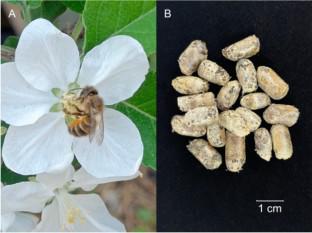Neotropical Entomology ( IF 1.8 ) Pub Date : 2024-03-13 , DOI: 10.1007/s13744-023-01122-5 Zhaoyun Lyu , Min Feng , Lei Nie , Ting Zhou , Kai Yu , Lili Li , Xingyuan Men , Meng Sun , Yi Yu

|
The mason bee Osmia excavata Alfken is an apple pollinating insect widely distributed in northern China, in order to effectively utilize the mason bee and improve the pollination rate of apples, there is a need to evaluate the pollination efficiency of the bees. This study evaluated the pollination efficiency of the mason bee on apple orchards in Jinan and Yantai, Shandong Province, China. The study compared natural pollination areas and pollination areas with different release densities of O. excavata in terms of the effects of bee density, timing of pollination, and distance effects on fruit set rate, fruit shape index, fruit shape skewness, fruit soluble solids content, and fruit firmness. The optimal release density of bees was 6000 cocoons per hectare, resulting in the highest fruit setting rate of apple lateral flowers. From 07:00 to 14:00 was the best time for bee pollination. The optimal distance of hives from apple trees for pollination by O. excavata was 60 m. Single fruit weight was significantly higher and fruit unsymmetrical rate, partial slope and hardness were all significantly lower at the release densities of 6000 or 12000 cocoons per hectare compared with 3000 cocoons per hectare or under natural pollination conditions. There was no significant difference in the content of soluble solids under different release densities. Thus, the radius of 60 m from the hive was the effective pollination range and 6000 cocoons per hectare of mason bees could ensure the fruit quality of apple.



























 京公网安备 11010802027423号
京公网安备 11010802027423号